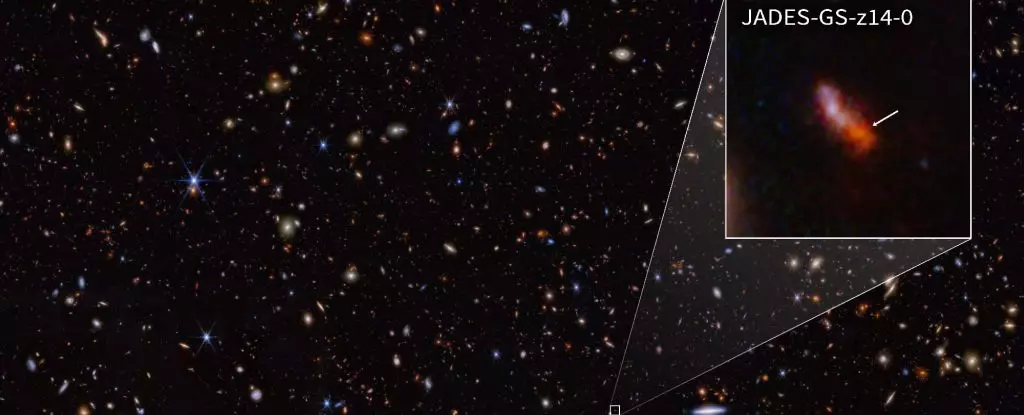

In a recent breakthrough in astrophysics, a newly discovered galaxy named JADES-GS-z14-0 has set a new record as the earliest galaxy ever seen. This discovery has perplexed astronomers and poses a significant challenge to our current understanding of galaxy formation. The galaxy is shining brightly in the early Universe, appearing less than 300 million years after the Big Bang. Another discovery, JADES-GS-z14-1, has also been confirmed to be nearly as distant. These findings have led astronomers to reconsider the processes that govern the formation of galaxies in the early Universe.
Upon close examination, astronomers have determined that the galaxy JADES-GS-z14-0 is at a redshift of 14.32, making it the most distant galaxy ever observed. The galaxy spans over 1,600 light-years and emits a significant amount of starlight, indicating a mass several hundred million times that of the Sun. This raises intriguing questions about how such a massive and luminous galaxy could have formed in less than 300 million years. The findings have been detailed in three separate papers, with one published in Nature and the other two awaiting peer review on arXiv.
The early Universe, particularly the period known as the Cosmic Dawn, has long been a subject of mystery due to the scattering of light by a fog of neutral hydrogen. However, recent advancements, including the discovery of JADES-GS-z14-0, are shedding new light on this era. The fog of neutral hydrogen was eventually ionized and cleared by ultraviolet light from early celestial objects, allowing for increased transparency. The presence of galaxies and stars during the Cosmic Dawn period has prompted astronomers to refine their models of galaxy formation.
The James Webb Space Telescope (JWST) has played a crucial role in uncovering the mysteries of the early Universe. With its powerful infrared capabilities, JWST has been able to peer through the dense media that hinder visible light. The JWST Advanced Deep Extragalactic Survey (JADES) has yielded fascinating results, including the discovery of galaxies dating back to the first 650 million years after the Big Bang. Surprisingly, these findings have challenged existing assumptions about the timeline for the formation of supermassive black holes and galaxies.
The discovery of JADES-GS-z14-0 has forced astronomers to rethink their understanding of early galactic evolution. The galaxy’s size and brightness suggest that the predominant source of light is young stars rather than surrounding supermassive black holes. Analysis of its light has revealed the presence of dust and oxygen, indicating the existence of multiple generations of stars that have lived and died by 300 million years after the Big Bang. These findings defy conventional wisdom and indicate that galaxies may have formed much earlier than previously thought.
The recent discovery of JADES-GS-z14-0 has revolutionized our understanding of early galaxy formation in the Universe. By challenging existing models and revealing the presence of large, bright galaxies in the Cosmic Dawn era, astronomers are faced with reevaluating their assumptions about the evolution of the cosmos. These groundbreaking findings highlight the need for continued exploration and observation to unravel the mysteries of the Universe’s infancy.
Gravity, one of the fundamental forces of nature, has long captivated the minds of physicists.…
The surge in artificial intelligence (AI) technologies has prompted a growing recognition of the need…
Mars, the enigmatic red planet that has long captivated researchers and enthusiasts alike, is not…
Molecular chemistry operates under the principle that no molecule exists in isolation. The properties and…
The quest for cleaner skies in the United States has yielded significant reductions in air…
The European Space Agency's (ESA) BepiColombo mission has recently achieved a remarkable milestone by executing…
This website uses cookies.